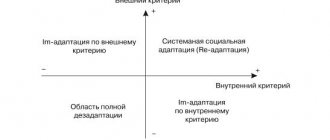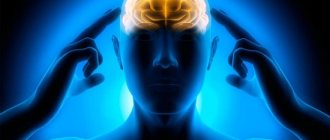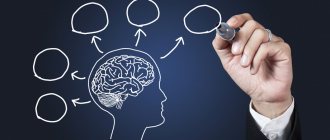Human adaptive capabilities
Adaptation is the adaptation of the body, personality, and their systems to the nature of individual influences or to changing conditions of life in general. Depending on the external conditions and at what level a person interacts with the environment, the following types of adaptation are distinguished: biological, physiological, psychological, social.
Psychological adaptation is the process of harmonizing the individual and the environment during the implementation of human activities, allowing a person to satisfy current needs and realize significant goals associated with them while ensuring compliance of activities and behavior with the requirements of the environment. Adaptation compensates for the insufficiency of habitual behavior in new conditions. If adaptation does not occur, additional difficulties arise in mastering the subject and conditions of activity, up to violations of its regulation. The adaptation process includes physiological, endocrine and other reactions of the body, mental processes, experience, states and personality traits.
Adaptation factors
can be divided into two groups.
The first group
includes the personality traits of the person himself.
These are characteristics such as general and special preparedness, character, temperament, mental processes, initial mental state and age. The second group
consists of objective factors. These factors are: means of becoming familiar with the nature of the situation and the tasks being solved, the qualities and example of others, and preparatory work. Adaptation is accelerated if preliminary work has been done to become familiar with possible situations and actions.
In the theory of mental adaptation, a distinction is made between stable adaptation, re-adaptation, disadaptation, readaptation
.
Sustainable adaptation
is determined by regulatory reactions, mental activity, and a system of relationships that arose in the process of human development in specific environmental and social conditions and do not require significant neuropsychic stress.
Mental disadaptation
is a state of “breakthrough” of adaptation barriers and breaking of existing dynamic stereotypes of mental activity under prolonged and strong influence of extreme factors.
Mental re-adaptation
is a person’s adaptation to changing living conditions.
Readaptation
is the process of returning a person from changed conditions to normal ones, with the abandonment of new dynamic stereotypes and the restoration of old ones. The longer the period of stay in changed conditions, the more difficult and longer the readaptation occurs.
IN AND. Lebedev identified the following stages of the adaptation–readaptation process:
: preparatory, starting mental stress, acute mental reactions of entry, readaptation, final mental stress, acute mental reactions of exit, readaptation.
IN AND. Lebedev identified four criteria that allow unusual (but still normal) reactions and conditions to be separated from pathological ones. The first is the certainty of connection with the environment. Secondly, pseudopathological reactions and the condition differ from pathology in their short duration. Third, a person remains critical of unusual conditions. Fourth, if a person in changed conditions was convinced of the reality of some unusual phenomenon, then after returning to normal conditions he easily abandons his conviction, following the arguments of others.
The formation of a person’s psychological readiness for activity in extreme conditions is based on his adaptive capabilities. Adaptive capabilities are the most important factor ensuring high emotional and neuropsychic stability of a person. The methods for determining a person’s adaptive potential are as follows: – the “Forecast” questionnaire for assessing neuropsychic stability (developed by the St. Petersburg Military Medical Academy); – “Adaptability” questionnaire to measure mental regulation, communicative potential, moral standards, adaptive ability (A. Maklakov, S. Chermyanin); – D. Taylor’s method of assessing the level of anxiety; – assessment of the level of anxiety using the method of Ch.D. Spielberger (modified by Yu.L. Khanin).
KONSPEKTY.NET
Adaptation is a person’s ability to adapt to the surrounding reality. This process is an integral part of our life. The higher a person’s adaptive abilities, the easier it is for him to build his life in society.
The ability to adapt has always been a necessary skill for humans. This was especially true in those times when people were maximally dependent on the environment and had to adapt to existing natural conditions. Since then, the world has changed a lot, but a person’s adaptive capabilities still play a huge role in his life. It is important to develop and maintain the ability to adapt to any situation. Thus, a person who knows how to easily establish contact with new people never experiences difficulties when changing places of study or work, if necessary, seek help or advice from strangers, etc. A person’s adaptive capabilities largely depend on his upbringing. If parents in childhood paid enough attention to the development of these child’s abilities (for example, going hiking, playing sports, constantly meeting new children, etc.), then in the future he will not have problems with adaptation.
Typically, there are three types of human adaptive capabilities: biological, social and ethnic. (We have an article about human cognitive capabilities ). The biological type of adaptation is responsible for the ability of the human body to adapt to existing environmental conditions. The first people who find themselves in certain natural conditions begin to develop those functions and abilities of the body that are most useful in the current conditions. All subsequent generations already receive the necessary properties, which are passed on by inheritance. The social type of adaptation is the ability to adapt to social norms and requirements, to join a certain social group. Ethnic adaptation is a whole complex of physiological, cultural, social characteristics characteristic of a certain people living in a specific territory.
Each person develops these capabilities differently. Moreover, the same person can combine different possibilities for adaptation, depending on the type of conditions to which one needs to adapt. For example, a person can easily adapt to a new company, in a new workplace, in a new city and, at the same time, have difficulty adapting to a new diet and daily routine. That is, a person can always adapt to anything, but one thing is easy for him, while another requires great emotional and physical costs. There are situations when a person is placed in conditions that are absolutely unbearable for him. At the same time, there is no way out of this situation. A person has no choice but to adapt to the proposed circumstances and adapt to the situation. At first, this can cause stress and deterioration in physical and emotional well-being. But, as you get used to it and go through the adaptation process, it will become much easier for a person to perceive the current situation. Gradually, he will enter into a routine and develop a certain model of behavior for himself, which he will adhere to.
Download this material:
Please rate the material you read :)
( 2 rated, rating: 4.00 out of 5) Loading…
Related Posts
- What do human needs depend on? Needs…
- Video: Etiquette and image of a business person? Components…
- Video: Human adaptive capabilities
- Human facial expressions psychology
- Human cognitive capabilities and cognitive goals
- Book review: Dmitry Zhukov - Stop, who leads...
- Etiquette and image of a business person. Components of a person's image
- Video: How to find out your capabilities?
- Studying personality from a person's handwriting or...
- Book summary: Dmitry Zhukov - Wait, who...
- The meaning of human life in philosophy
- How to find out your capabilities?
Systems that provide adaptation.
Afferent link. The afferent link of the functional adaptation system consists of receptors, as well as sensory neurons and sets of afferent nerve cells in the central nervous system. All these elements of the nervous system perceive irritations from the external environment and from the body itself and participate in the implementation of the so-called afferent synthesis necessary for adaptation. Afferent synthesis occurs according to P.K. Anokhin, with the interaction of motivation, memory, situational and triggering information. In sports, in some cases (for example, runners, skiers, gymnasts), afferent synthesis for making a decision about the beginning of one’s movements is relatively simple and this facilitates the formation of an adaptive system, while in others (martial arts, sports games), it is very complex and this makes it difficult formation of such a system.
Central regulatory link. The central regulatory link of the functional system is represented by neurogenic and humoral processes controlling adaptive reactions. In response to afferent signals, the neurogenic part of the unit includes a motor response and mobilizes the autonomic systems based on the reflex principle of regulation of functions. Afferent impulses from receptors to the cerebral cortex cause the emergence of positive (excitatory) and negative (inhibitory) processes, which form a functional adaptive system. In an adapted organism, the neurogenic part of the unit quickly and clearly responds to afferent impulses with appropriate muscle activity and mobilization of autonomic functions. There is no such perfection in an unadapted organism. Muscular movement will be performed approximately, and autonomic support will be insufficient. When a signal about physical activity is received, simultaneously with the changes described above, neurogenic activation of the humoral part of the central regulatory link occurs, which is responsible for the significance of humoral reactions (increased release of hormones, enzymes and mediators) determined by the fact that they, by influencing the metabolism of organs and tissues, provide more complete mobilization functional adaptive system and its ability to work for a long time at an increased level.
Effector link. The effector link of the functional adaptation system includes skeletal muscles, respiratory organs, blood circulation, blood and other autonomic systems. The intensity and duration of physical activity at the skeletal muscle level is determined by three main factors:
- the number and type of motor units activated;
- the level and nature of biochemical processes in muscle cells;
- characteristics of the blood supply to the muscles, which determines the flow of oxygen, nutrients and the removal of metabolites.
An increase in the strength, speed and accuracy of movements in the process of long-term adaptation is achieved by two main processes: the formation in the central nervous system of a functional movement control system and morphofunctional changes in muscles (muscle hypertrophy, an increase in the power of aerobic and anaerobic energy production systems, an increase in the amount of myoglobin and mitochondria, a decrease in the formation and accumulation ammonia, redistribution of blood flow, etc.)
Adaptation factors
The external environment has many natural factors and factors created by man himself (material and social environment), under their influence personality adaptation is formed.
Natural factors of adaptation: components of wildlife, climatic conditions, cases of natural disasters.
The material environment includes the following adaptation factors: environmental objects; artificial elements (machines, equipment); immediate living environment; work environment.
The social environment has the following adaptation factors: state society, ethnicity, conditions of a modern city, and associated social progress.
The most unfavorable environmental factors are considered to be anthropogenic (technogenic). This is a whole complex of factors that a person needs to adapt to, since he lives in these conditions every day (man-made electromagnetic pollution, the structure of highways, landfills, etc.).
The pace of adaptation relative to the factors described above is individual for each person. Some people can adapt faster, while others find this process very difficult. A person's ability to actively adapt to the environment is called adaptability. Thanks to this property, it is much easier for a person to move, travel, or find himself in extreme conditions.
According to one theory, the success of the adaptation process is influenced by two groups of factors: subjective and environmental. Subjective factors include: demographic characteristics (age and gender) and psychophysiological characteristics of the person.
Environmental factors include: conditions and circumstances of life, nature and mode of activity, conditions of the social environment. Demographic factors, in particular a person’s age, have a two-way influence on the successful adaptation process. If you look from one side, the age of a young person provides him with more opportunities, but in old age these opportunities decrease. But, with age, a person gains experience of adaptation, he finds a “common language” with the external environment.
Another psychological theory identifies four psychological factors in personality adaptation. The cognitive factor includes cognitive abilities and specific features of cognitive processes. The emotional response factor includes features of the emotional sphere. Practical activity is a factor in the conditions and characteristics of an individual’s activity. Personal motivation is a special factor in personal adaptation. For example, if a person’s motivation to achieve success prevails over the motivation to avoid failure, then successful adaptation is formed and key activities become more effective. The nature of adaptation is also influenced by the correspondence of the motivational personal core to the goals and conditions of the activity. Motive is a factor of adaptation and with its help the influence of external circumstances on the individual is mediated.
Human biological adaptive rhythms
Definition 2
Biological rhythms are understood as periodic, regular qualitative and quantitative changes in the course of life processes at all levels of organization of a living organism.
Chronobiology studies biorhythms. It examines the relationship between behavior, life processes of organisms and environmental influences.
Biorhythms are of two types:
- external biorhythms are associated with changes in the position of the Earth relative to the Sun, Moon and other celestial bodies;
- internal biorhythms include heart rate, breathing rhythm, digestive tract, excretory organs, etc.
Biological rhythms make it possible to maintain the constancy of the internal environment of the body, adapt to changes in the environment, and are a mechanism for regulating vital functions. They have different periodicities: from fractions of seconds to several years.
Example 2
The most important daily human biorhythm is the alternation of periods of wakefulness and sleep. This ratio is individual for each person, but on average the sleep period is from 6 to 10 hours (8 hours is considered optimal).
The condition of the human body directly depends on the functioning of internal biorhythms. The course of various physiological processes fluctuates throughout the day. Moreover, different physiological functions have different periodicities.
There are several patterns of biorhythmicity:
- human body temperature in the daytime is higher than at night (the highest value is observed at 18.00);
- the intensity of physiological processes increases in the morning and decreases in the evening;
- metabolism occurs more intensely during the day than at night;
- In pathological processes, rhythm is disrupted.
Daily biorhythms are controlled by a special adaptive mechanism that provides orientation to organisms in time - the “biological clock”. This mechanism is based on periodic physical and chemical processes occurring in the body.
Adaptive capabilities of the child’s bodyarticle on the topic
Adaptation of the body
The process of adaptation to the environment begins from the moment of birth - every minute, every second. The body has to adapt to fluctuations in temperature, atmospheric pressure, the influence of microorganisms, nutritional factors, and an endless variety of psychological, social and other influences. The essence of the adaptation is that the body changes the intensity, rhythm and nature of the processes occurring in it in such a way that the main indicators of the internal environment, despite the action of external factors, are firmly maintained within the physiological parameters [10].
This process of adapting the body to the external environment or changes occurring in the body itself is adaptation. Adaptation is also the result of achieving compliance of the morphofunctional state of the organism with the conditions of activity that the environment creates for it [19, 45, 49].
The main and fundamental question that requires scientific coverage is through what mechanisms and what chain of phenomena does an unadapted organism become adapted.
Since the human body is a complex, dynamic, multifunctional system, adaptation includes all types of adaptation to general natural, industrial, and social conditions. Therefore, they talk about temperature, sensory, pain, mental, labor, etc. adaptation.
There are genotypic and phenotypic adaptations. The first was formed in the process of human evolution on the basis of hereditary variability, mutation, and natural selection. Her achievements are fixed genetically and are inherited. Phenotypic adaptation is formed in the process of a person’s individual life and his interaction with the environment. Phenotypic changes acquired during life are layered on hereditary characteristics and form the individual appearance of the organism, characterized by a set of morphofunctional changes aimed at maintaining the relative constancy of its internal environment - homeostasis.
As a result of the development of adaptive reactions, the body acquires a new quality in the form of resistance to hypoxia, cold, physical activity, new motor skills, etc. This new quality is manifested primarily in the fact that the body cannot be damaged by the factor to which adaptation has been acquired. Essentially, such reactions form the basis of hardening, health promotion and disease prevention in the process of health-improving physical exercises. The role of adaptation as a factor of prevention is manifested in the fact that the body’s resistance increases to the action of not only one factor, but also several, i.e. We are talking about combined adaptation. In sports activities, for example, during the training and competition of skiers, simultaneous adaptation to physical activity requiring endurance, cold, hypoxia, and stressful situations occurs [59].
Adaptation to physical work is based on the body’s adaptive reactions in response to the changing demands of the internal and external environment. Physical activity acts as an adaptogen, and its structural unit is physical exercise.
1.2. The mechanism of action of the body's adaptive capabilities
Initially, the mechanism of action of physical exercise consists of excitation of the corresponding afferent and motor centers, mobilization of skeletal muscles, blood circulation and respiration, which together form a single functional system responsible for the implementation of this motor reaction [3]. However, the effectiveness of this system is low, and the body’s reaction does not mean immediate adaptation. This is only the basis of the initial stage of urgent adaptation, which is an emergency reaction of various organs and systems, compensating for the impact of external factors. But these reactions are not fixed and quickly disappear if they do not exceed the physiological capabilities of the body at the moment.
In order for a stable adaptation to develop, reinforcement, training, and repeated external influences are necessary. As a result of an increase in physiological capabilities, cumulative adaptation is formed. This is a complex and lengthy process of gradual functional restructuring of the body [44].
During intense sports training, it is associated with the activation and mobilization of the body's functional resources, the intensive occurrence of structural and functional transformations in organs and tissues.
According to V.N. Platonov [54], sustainable long-term adaptation is characterized by the presence of the necessary reserve to ensure a new level of system functioning, the stability of functional structures, and the close relationship of regulatory and executive bodies. V.V. Petrovsky [53], V.M. Volkov, A.A. Semkin [13] characterize it as a state of highest performance, expressed in the formation of an effective structure of movements, increasing the rate of voluntary muscle relaxation (technical economization), accelerating the work-in process, reducing energy consumption per unit of work performed, increasing oxygen utilization, optimizing recovery processes (functional economization) .
Long-term adaptation is expressed, on the one hand, in an increase in the power of self-regulation mechanisms, on the other, in an increase in the reactivity of these systems to control signals. As a result, the balancing of the adapted organism with the external environment is achieved with a lesser degree of inclusion of the higher levels of the regulatory hierarchy - with a more economical functioning of the neuroendocrine regulation of the systems responsible for adaptation [46].
Particular attention is paid to the body’s adaptation to extreme, stressful conditions, from which it is impossible to escape through simple avoidance reactions. Such situations occur in various types of human activity associated with responsibility, risk, the need to maintain restraint, regulate behavior and emotions.
Throughout an individual’s life, a person is repeatedly exposed to stress, as a result of prolonged and intense action of which stress diseases develop. Currently, the role of stress as an etiological factor in coronary heart disease, hypertension, atherosclerosis, gastric ulcers, even malignant tumors and immunodeficiency conditions that limit human life has been proven [45, 71].
Stressors include such natural forms of our time as environmental disasters, wars, loss of loved ones, physical injuries, injuries, etc. Socially determined stress situations as a result of interpersonal conflicts associated with humiliation, deception, betrayal, etc. are no less widespread. collapse of hopes, disappointment, etc. Many disabled people find themselves in a similar situation, having suddenly lost a limb, vision or hearing, when so-called hopeless stressful situations arise. The conflict of people who find themselves in a difficult situation lies in the need to implement a defensive reaction of self-preservation and the impossibility, an insurmountable prohibition, to implement it in the created conditions [64].
However, most people who find themselves in hopeless situations do not die, but acquire one or another degree of resistance (stability) to these stressful situations.
The fact is that when exposed to various extreme factors, both physical and mental, the same type of biochemical changes occur in the body, aimed at overcoming the effects of these factors by adapting the body to the requirements. G. Selye [62] called the set of changes occurring in the body under the influence of stressors the adaptation syndrome. The severity of these changes depends on the intensity of stress, the functional state of physiological systems and the nature of human behavior. According to G. Selye, no vigorous activity is possible without stress; complete freedom from stress is tantamount to death. Therefore, stress is not only harmful, but also beneficial for the body. It mobilizes its capabilities and increases resistance to negative influences.
Behavioral reactions to a stressful situation are important for the nature of the consequences of stress. An active search for ways to change it leads to the body’s resistance; if the active search is abandoned, the resistance phase of the adaptation syndrome passes into the exhaustion phase and, in severe cases, can lead the body to death.
So, even the most general knowledge about the patterns of the body’s adaptation processes is of strategic importance for understanding the biological essence of the theory and methodology of adaptive physical culture. However, today the following important theoretical and applied problems remain unresolved: such as managing long-term adaptation of the body of people with disabilities of various nosological groups in the process of physical education, sports, recreational activities and motor rehabilitation; rationing physical activity and adaptation to it; tactics of adaptation to the action of several environmental factors; ensuring complex forms of social adaptation through movement; adaptation of the body to extreme stress situations; quantitative and qualitative assessment of adaptation processes, etc.
Acupressure is one of the most ancient methods of treatment. It arose in the East, on the territory of modern China, Korea, Mongolia and Japan after ancient healers drew attention to the fact that there are special “vital” points on the human body associated with internal organs and systems. By influencing these points, it was possible not only to improve the general condition of the patient, but also to restore impaired organ functions.
1.3. Rationale for the acupressure technique
Acupressure (point pressure according to Zhu Lian, finger zhen), or pressing, is the impact on acupuncture points (AP) with a finger (fingers). The ease of performing acupressure and its effectiveness contribute to the widespread use of this method.
The essence of acupressure is reduced to mechanical irritation of small areas (2-10 mm) of the skin surface, which are called biologically active points (BAP), since they contain a large number of nerve endings.
To date, scientists and specialists have described about 700 BAPs, of which 140-150 are the most commonly used.
To find BAP, one should use anatomical and topographical signs (tubercles, ligaments, muscles, bones, etc.). However, these landmarks are clearly not enough to find some BAPs. In I, a unique measure helps in finding them: individual cun - the distance between two folds that are formed when bending the second phalanx of the middle finger of the right hand in women and the left in men. It turned out that all parts of our body can be conditionally divided into a certain number of equal parts. Their border is called the proportional cun, which varies between 1-3 cm depending on the person’s physique. Everyone can make a measuring tape for themselves with their own tsunami.
Before starting a massage, it is necessary to clearly study the location of BAPs and learn to regulate the force of influence on them depending on their location - near bones, ligaments, vessels, nerves, etc. A weaker effect is exerted on blood vessels and nerves. The principle of choosing BAP for acupressure is determined primarily by the nature of the disease (trauma) and its main symptoms.
Acupressure is based on the mechanical impact of a finger (fingers) on biologically active points (BAP), which have a reflex connection (through the nervous system) with various internal organs and functional systems. The correct location of the point is indicated by a feeling of aching, bloating, or numbness. Very often the point responds with pain. The soreness of any point (zone) can sometimes suggest a disease of a particular organ.
Acupressure technique
The acupressure technique includes various techniques: rubbing, stroking, pressure (pressure), vibration, grasping, etc.
Technique - stroking is performed with the pad of the thumb (or middle) finger with rotational movements. It is used mainly in the area of the head, face, neck, hands and, in addition, at the end of the entire procedure.
Technique - rubbing is done with the pad of the thumb or middle finger in a clockwise direction. Moreover, rubbing is used independently and, as a rule, after all other acupressure techniques.
Technique - kneading (pressure) is performed with the tip of the thumb or two thumbs (at symmetrical points), as well as with the middle or index finger. When doing this, they make circular rotational movements with the finger - at first slowly and weakly, gradually increasing the pressure until a feeling of fullness appears at the site of the massage, then loosen the pressure, etc. Grasping (“pinch”) is performed with three fingers of the right hand (index, thumb and middle ). At the location of the BAP, the skin is grabbed into a fold and kneaded and squeezed. The movement is performed quickly, abruptly 3-4 times. At the site of acupressure, a feeling of swelling usually appears.
Technique - “injection” is performed with the tip of the index finger and thumb at a fast pace.
Technique - vibration is performed with a large or medium finger. Make oscillatory movements quickly, without lifting your finger from the massaged point. This technique can be used with weights, when another hand is placed on the massaging brush to increase pressure (on large muscles).
The calming or stimulating effect of acupressure depends on the nature of the irritation.
Since disturbances in physical development reduce the adaptive capabilities of a schoolchild’s body, we consider it advisable to use acupressure in the process of correcting the body’s condition.
1.4. Basic principles of acupressure
The following principles are basic for acupressure massage:
1. An integrated approach to the treatment of each disease.
2. Slowness and thoroughness of all treatment methods.
3. Treatment of each patient should be purely individual.
Studying the work of Eastern specialists in acupressure, modern researchers have come to the conclusion that “biologically active points” (BAP) have a number of specific features:
—low electrocutaneous resistance;
— high electrical potential;
-high skin temperature;
—high pain sensitivity;
—increased oxygen absorption;
-high level of metabolic processes.
You can determine the location of a particular point by simply pressing your fingertips on the surface of the skin. When a point is hit, a person experiences a feeling of aching, numbness, and even pain. One of the advantages of acupressure is that the technique for performing it is quite simple; it does not require additional equipment or expensive devices. In addition, the area of influence during acupressure is very small. Acupressure can be used before special medical care is provided, as well as in combination with other treatment methods.
Basics of acupressure.
The action of acupressure is based on the most ancient idea of the structure of the human body. According to this idea, “vital energy”—“chi”—flows through the invisible meridian channels of the human body. There are only fourteen such channels: 12 paired and 2 unpaired. And as long as “chi” does not encounter obstacles on its path, each channel, receiving an equal amount of energy, carries it to all internal organs and nourishes them. As soon as the uniform flow of “chi” is disrupted, the amount of vital energy in different parts of the body becomes unequal, and the person falls ill.
This theory echoes another ancient Eastern theory that every phenomenon is based on two principles: “yin” and “yang.”
Yin, which carries a negative charge, is the maternal principle: cold, wet, dark, secretive, passive and changeable. Yang, which carries a positive charge, is the paternal principle: warm, dry, bright, obvious, proactive, constant. Following this theory, in the human body there is a constant confrontation between two opposing principles: yang and yin. Therefore, all processes occurring in it are either positive or negative. Reconciling them is the main task of Eastern medicine.
According to another ancient Eastern theory, the internal organs of a person are connected with the five primary elements of the earth: the heart - with fire, the spleen - with earth, the kidneys - with water, the liver - with wood, the lungs - with metal. One thing follows from all these theories: all internal organs in the human body are interconnected, and man is part of nature.
Literature
1. Ado A.D. Questions of general nosology. M., 1985.
2. Anokhin P.K. General principles of compensation for impaired functions and their physiological basis. M., 1956.
3. Anokhin P.K. Essays on the physiology of functional systems. M., 1975.
4. Balsevich V.K. The phenomenon of physical activity as a socio-biological problem // Issues of Philosophy, 1981, No. 8.
5. Balsevich V.K. Physical education for everyone and for everyone. M., 1988.
6. Balsevich V.K. Intellectual vector of physical culture // Theor. and practical physical cult., 1991, No. 7.
7. Balsevich V.K. Evolutionary biomechanics: theory and practical applications // Teor. and practical physical cult., 1996, No. 11.
8. Vasilenko V.Kh. Introduction to the clinic of internal diseases. M., 1985.
9. Introduction to the theory of physical culture: Textbook. village /Ed. L.P. Matveeva. M., 1983.
10. Vereshchagin V.Yu. Philosophical aspects of the problem of human biological adaptation. L., 1984.
11. Visharenko V.S. Determinism in biological processes. L., 1975.
12. Volzhin A.I., Subbotin Yu.K. Adaptation and compensation are a universal biological mechanism of adaptation. M., 1987.
13. Volkov V.M., Semkin A.A. Athlete reserves: Method. village Minsk, 1993.
14. Vygotsky L.S. Fundamentals of defectology // Collection. soch., vol. 5. M., 1983.
15. Vydrin V.M. Physical recreation - a type of physical culture // Theor. and practical physical cult., 1983, No. 3.
16. Vydrin V.M. Physical culture and its theory // Theor. and practical physical cult., 1986, No. 5.
17. Vydrin V.M., Kuramshin Yu.F., Nikolaev Yu.M. Understanding the integrative essence of physical culture - the main path of its theory // Theor. and practical physical cult., 1996, No. 5.
18. Gazenko O.G., Meerson F.Z. Physiology of adaptation processes. M., 1986.
19. Davidenko D.N. Physiological foundations of physical culture and sports: Textbook. village St. Petersburg, 1996.
20. Davydovsky I.V. Problems of causation in medicine: Etiology. M., 1962.
21. Davydovsky I.V. General human pathology. M., 1969.
22. Danilova L.Ya. Reactivity and its role in pathology: Pathological physiology / Textbook. for honey Institutes, 1994.
23. United Nations Declaration on the Rights of Persons with Disabilities, 1975, paragraph 2.1.
24. Dembo A.G. Diseases and injuries during sports. L., 1991.
25. Dmitriev A.A. Theoretical foundations of physical education of abnormal children // Interuniversity. Sat. scientific tr. Krasnoyarsk, 1991.
26. Dmitriev V.S., Somaeva G.N. Kiseleva E.V. Fundamentals of the prevention of physical inactivity and hypokinesia in disabled people by means of physical culture and sports. Malakhovka, 1993.










